Composition, Technological, and Microstructural Aspects of Concrete Modified with Finely Ground Mussel Shell Powder
Abstract
1. Introduction
- –
- To search for ways to rationally process mussel shells as a valuable raw material source to obtain a new generation modifier that can significantly improve the composition and structure of concrete.
- –
- To study the SSC of modified concrete, reflecting its performance and applicability in various structures.
- –
- To assess concrete in terms of efficiency, including a reflection on its environmental impact.
2. Materials and Methods
2.1. Materials
2.2. Methods
- –
- Dosing the CM components;
- –
- Mixing Portland cement and quartz sand in a concrete mixer for 2 min;
- –
- Adding the required dosage of MSP and mixing until a homogeneous consistency was obtained;
- –
- Introduction of mixing water and coarse aggregate;
- –
- Mixing of the concrete mix to a homogeneous condition;
- –
- Unloading the resulting mixture from the concrete mixer and molding the samples;
- –
3. Results and Discussion
4. Conclusions
- (1)
- The modification of concrete with the finely ground powder of mussel shells makes it possible to enhance the structure formation and SSC, provided that the optimal dosage of such a modifier is observed.
- (2)
- Replacing part of the cement in the concrete with mussel shell powder at an amount of 6% leads to better concrete performance values.
- (3)
- Replacing cement with MSP by up to 10% does not adversely affect strength characteristics, while adding more than 10% MSP leads to a drop in strength characteristics.
- (4)
- The modification of concrete with MSP at an amount of 6% provides an increase in CS by up to 12%, axial CS-up to 13%, TS in bending-up to 14%, axial TS-up to 12%, and ME-up to 15%. The addition of MSP in an amount from 0 to 6% gives a smooth increase in concrete strength and ME, while the addition of MSP from 6 to 12% leads to a sharp drop in concrete strength and ME.
- (5)
- The modification of concrete with MSP at an amount of 6% provides a reduction in the ultimate deformations of compression and tension by up to 12%, and an increase in the dosage by 12% leads to an increase in deformations up to 14%.
- (6)
- SEM analysis showed that concrete with 6% MSP has a more integral microstructure, without voids and cracks in comparison with the control sample, and also contributes to the additional formation of CSH gel zones, which ensures an increase in the strength characteristics of the composite.
Author Contributions
Funding
Institutional Review Board Statement
Informed Consent Statement
Data Availability Statement
Acknowledgments
Conflicts of Interest
Abbreviations
| BD | Bulk Density |
| CC | Chemical Composition |
| CM | Concrete Mixture |
| CS | Compressive Strength |
| CrS | Crushed Stone |
| ME | Modulus of Elasticity |
| MSP | Mussel Shell Powder |
| PC | Portland Cement |
| PSD | Particle Size Distribution |
| QS | Quartz Sand |
| SSC | Strength and Deformation Characteristics |
| TD | True Density |
| TS | Tensile Strength |
| USAC | Ultimate Strains in Axial Compression |
| USAT | Ultimate Strains in Axial Tension |
References
- Horiguchi, I.; Mimura, Y.; Monteirob, P.J.M. Plant-growing performance of pervious concrete containing crushed oyster shell aggregate. Clean. Mater. 2021, 2, 100027. [Google Scholar] [CrossRef]
- Tayeh, B.A.; Hasaniyah, M.W.; Zeyad, A.M.; Yusuf, M.O. Properties of concrete containing recycled seashells as cement partial replacement: A review. J. Clean. Prod. 2019, 237, 117723. [Google Scholar] [CrossRef]
- Alvarenga, R.A.F.; Galindro, B.M.; Helpa, C.F.; Soares, S.R. The recycling of oyster shells: An environmental analysis using Life Cycle Assessment. J. Environ. Manag. 2012, 106, 102–109. [Google Scholar] [CrossRef] [PubMed]
- Peceño, B.; Leiva, C.; Alonso-Fariñas, B.; Gallego-Schmid, A. Is Recycling Always the Best Option? Environmental Assessment of Recycling of Seashell as Aggregates in Noise Barriers. Processes 2020, 8, 776. [Google Scholar] [CrossRef]
- Beskopylny, A.N.; Stel’makh, S.A.; Shcherban’, E.M.; Mailyan, L.R.; Meskhi, B.; Efremenko, I.; Varavka, V.; Beskopylny, N.; Dotsenko, N. Modeling and Experimental Verification of the Performance of Polymer Composite Reinforcing Bars of Different Types in Concrete of Different Density. Polymers 2022, 14, 1756. [Google Scholar] [CrossRef]
- Wanga, J.; Liua, E.; Li, L. Characterization on the recycling of waste seashells with Portland cement towards sustainable cementitious materials. J. Clean. Prod. 2019, 220, 235–252. [Google Scholar] [CrossRef]
- Bouasria, M.; Khadraoui, F.; Benzaama, M.H.; Touati, K.; Chateigner, D.; Gascoin, S.; Pralong, V.; Orberger, B.; Babouri, L.; Mendili, Y.E. Partial substitution of cement by the association of Ferronickel slags and Crepidula fornicata shells. J. Build. Eng. 2021, 33, 101587. [Google Scholar] [CrossRef]
- Varhen, C.; Carrillo, S.; Ruiz, G. Experimental investigation of Peruvian scallop used as fine aggregate in concrete. Constr. Build. Mater. 2017, 136, 533–540. [Google Scholar] [CrossRef]
- Hera, S.; Park, T.; Zalnezhad, E.; Bae, S. Synthesis and characterization of cement clinker using recycled pulverized oyster and scallop shell as limestone substitutes. J. Clean. Prod. 2021, 278, 123987. [Google Scholar] [CrossRef]
- Foti, D.; Cavallo, D. Mechanical behavior of concretes made with non-conventional organic origin calcareous aggregates. Constr. Build. Mater. 2018, 179, 100–106. [Google Scholar] [CrossRef]
- Olivia, M.; Mifshella, A.A.; Darmayanti, L. Mechanical Properties of Seashell Concrete. Procedia Eng. 2015, 125, 760–764. [Google Scholar] [CrossRef]
- Martínez-García, C.; González-Fonteboa, B.; Martínez-Abella, F.; Carro-López, D. Performance of mussel shell as aggregate in plain concrete. Constr. Build. Mater. 2017, 139, 570–583. [Google Scholar] [CrossRef]
- Chen, D.; Zhang, P.; Pan, T.; Liao, Y.; Zhao, H. Evaluation of the eco-friendly crushed waste oyster shell mortars containing supplementary cementitious materials. J. Clean. Prod. 2019, 237, 117811. [Google Scholar] [CrossRef]
- Martínez-García, C.; González-Fonteboa, B.; Carro-López, D.; Martínez-Abella, F. Effects of mussel shell aggregates on hygric behaviour of air lime mortar at different ages. Constr. Build. Mater. 2020, 252, 119113. [Google Scholar] [CrossRef]
- Safi, B.; Saidi, M.; Daoui, A.; Bellal, A.; Mechekak, A.; Toumi, K. The use of seashells as a fine aggregate (by sand substitution) in self-compacting mortar (SCM). Constr. Build. Mater. 2015, 78, 430–438. [Google Scholar] [CrossRef]
- Fan, G.; Liu, H.; Liu, C.; Xue, Y.; Ju, Z.; Ding, S.; Zhang, Y.; Li, Y. Analysis of the Influence of Waste Seashell as Modified Materials on Asphalt Pavement Performance. Materials 2022, 15, 6788. [Google Scholar] [CrossRef]
- Lv, S.; Hu, L.; Xia, C.; Cabrera, M.B.; Guo, Y.; Liu, C.; You, L. Recycling fish scale powder in improving the performance of asphalt: A sustainable utilization of fish scale waste in asphalt. J. Clean. Prod. 2021, 288, 125682. [Google Scholar] [CrossRef]
- Lv, S.; Hu, L.; Xia, C.; Peng, X.; Cabrera, M.B.; Guo, S.; You, L. Surface-treated fish scale powder with silane coupling agent in asphalt for performance improvement: Conventional properties, rheology, and morphology. J. Clean. Prod. 2021, 311, 127772. [Google Scholar] [CrossRef]
- Soltanzadeh, F.; Behbahani, A.E.; Pereira, E.N.B.; Teixeira, C.A. A Life-Cycle Approach to Integrate Environmental and Mechanical Properties of Blended Cements Containing Seashell Powder. Sustainability 2021, 13, 13120. [Google Scholar] [CrossRef]
- Soltanzadeh, F.; Emam-Jomeh, M.; Edalat-Behbahani, A.; Soltan-Zadeh, Z. Development and characterization of blended cements containing seashell powder. Constr. Build. Mater. 2018, 161, 292–304. [Google Scholar] [CrossRef]
- Peceño, B.; Bakit, J.; Cortes, N.; Alonso-Fariñas, B.; Bonilla, E.; Leiva, C. Assessing Durability Properties and Economic Potential of Shellfish Aquaculture Waste in the Construction Industry: A Circular Economy Perspective. Sustainability 2022, 14, 8383. [Google Scholar] [CrossRef]
- Seo, J.H.; Park, S.M.; Yang, B.J.; Jang, J.G. Calcined Oyster Shell Powder as an Expansive Additive in Cement Mortar. Materials 2019, 12, 1322. [Google Scholar] [CrossRef] [PubMed]
- Liu, S.; Wang, Y.; Liu, B.; Zou, Z.; Teng, Y.; Ji, Y.; Zhou, Y.; Zhang, L.V.; Zhang, Y. Sustainable Utilization of Waste Oyster Shell Powders with Different Fineness Levels in a Ternary Supplementary Cementitious Material System. Sustainability 2022, 14, 5981. [Google Scholar] [CrossRef]
- Sangeetha, P.; Shanmugapriya, M.; Saravanan, K.S.; Prabhakaran, P.; Shashankarc, V. Mechanical properties of concrete with seashell waste as partial replacement of cement and aggregate. Mater. Today Proc. 2022, 61, 320–326. [Google Scholar] [CrossRef]
- Ahsan, M.H.; Siddique, M.S.; Farooq, S.H.; Usman, M.; Aleem, M.A.U.; Hussain, M.; Hanifcd, A. Mechanical behavior of high-strength concrete incorporating seashell powder at elevated temperatures. J. Build. Eng. 2022, 50, 104226. [Google Scholar] [CrossRef]
- Tayeh, B.A.; Hasaniyah, M.W.; Zeyad, A.M.; Awad, M.M.; Alaskar, A.; Mohamed, A.M.; Alyousef, R. Durability and mechanical properties of seashell partially-replaced cement. J. Build. Eng. 2020, 31, 101328. [Google Scholar] [CrossRef]
- Karimipour, A.; Ghalehnovi, M.; Edalati, M.; de Brito, J. Properties of Fibre-Reinforced High-Strength Concrete with Nano-Silica and Silica Fume. Appl. Sci. 2021, 11, 9696. [Google Scholar] [CrossRef]
- Cantero, B.; Bravo, M.; de Brito, J.; del Bosque, I.F.S.; Medina, C. The Influence of Fly Ash on the Mechanical Performance of Cementitious Materials Produced with Recycled Cement. Appl. Sci. 2022, 12, 2257. [Google Scholar] [CrossRef]
- Sabzi, J.; Asadi Shamsabadi, E.; Ghalehnovi, M.; Hadigheh, S.A.; Khodabakhshian, A.; Brito, J.D. Mechanical and Durability Properties of Mortars Incorporating Red Mud, Ground Granulated Blast Furnace Slag, and Electric Arc Furnace Dust. Appl. Sci. 2021, 11, 4110. [Google Scholar] [CrossRef]
- Cantero, B.; Bravo, M.; de Brito, J.; Sáez del Bosque, I.F.; Medina, C. Thermal Performance of Concrete with Recycled Concrete Powder as Partial Cement Replacement and Recycled CDW Aggregate. Appl. Sci. 2020, 10, 4540. [Google Scholar] [CrossRef]
- Thomas, C.; de Brito, J.; Corinaldesi, V. Special Issue High-Performance Eco-Efficient Concrete. Appl. Sci. 2021, 11, 1163. [Google Scholar] [CrossRef]
- Hasnaoui, A.; Bourguiba, A.; Mendili, Y.E.; Sebaibi, N.; Boutouil, M. A preliminary investigation of a novel mortar based on alkali-activated seashell waste powder. Powder Technol. 2021, 389, 471–481. [Google Scholar] [CrossRef]
- Hasnaoui, A.; Bourguiba, A.; Sebaibi, N.; Boutouil, M. Valorization of queen scallop shells in the preparation of metakaolin-based geopolymer mortars. J. Build. Eng. 2022, 53, 104578. [Google Scholar] [CrossRef]
- Nguyen, D.H.; Boutouil, M.; Sebaibi, N.; Baraud, F.; Leleyter, L. Durability of pervious concrete using crushed seashells. Constr. Build. Mater. 2017, 135, 137–150. [Google Scholar] [CrossRef]
- Peceño, B.; Arenas, C.; Alonso-Fariñas, B.; Leiva, C. Substitution of Coarse Aggregates with Mollusk-Shell Waste in Acoustic-Absorbing Concrete. J. Mater. Civ. Eng. 2019, 31, 04019077. [Google Scholar] [CrossRef]
- Martínez-García, C.; González-Fonteboa, B.; Carro-López, D.; Martínez-Abella, F. Impact of mussel shell aggregates on air lime mortars. Pore structure and carbonation. J. Clean. Prod. 2019, 215, 650–668. [Google Scholar] [CrossRef]
- Wang, Q.; Lu, Q.; Li, X.; Wang, Z.; Lyu, X. Characterization and comparison of the cement produced using clam wreckage and limestone: Cement clinker, freeze–thaw resistance, and hydration products. Constr. Build. Mater. 2021, 310, 125219. [Google Scholar] [CrossRef]
- Gigante, V.; Cinelli, P.; Righetti, M.C.; Sandroni, M.; Tognotti, L.; Seggiani, M.; Lazzeri, A. Evaluation of Mussel Shells Powder as Reinforcement for PLA-Based Biocomposites. Int. J. Mol. Sci. 2020, 21, 5364. [Google Scholar] [CrossRef]
- Seesanong, S.; Boonchom, B.; Chaiseeda, K.; Boonmee, W.; Laohavisuti, N. Conversion of Bivalve Shells to Monocalcium and Tricalcium Phosphates: An Approach to Recycle Seafood Wastes. Materials 2021, 14, 4395. [Google Scholar] [CrossRef]
- GOST 27006. Concretes. Rules for Mix Proposing. Available online: https://docs.cntd.ru/document/1200165762 (accessed on 11 December 2022).
- Beskopylny, A.N.; Stel’makh, S.A.; Shcherban’, E.M.; Mailyan, L.R.; Meskhi, B.; Smolyanichenko, A.S.; Varavka, V.; Beskopylny, N.; Dotsenko, N. Influence of Electromagnetic Activation of Cement Paste and Nano-Modification by Rice Straw Biochar on the Structure and Characteristics of Concrete. J. Compos. Sci. 2022, 6, 268. [Google Scholar] [CrossRef]
- Beskopylny, A.N.; Shcherban’, E.M.; Stel’makh, S.A.; Mailyan, L.R.; Meskhi, B.; Evtushenko, A.; Varavka, V.; Beskopylny, N. Nano-Modified Vibrocentrifuged Concrete with Granulated Blast Slag: The Relationship between Mechanical Properties and Micro-Structural Analysis. Materials 2022, 15, 4254. [Google Scholar] [CrossRef] [PubMed]
- Beskopylny, A.N.; Stel’makh, S.A.; Shcherban’, E.M.; Mailyan, L.R.; Meskhi, B.; Varavka, V.; Beskopylny, N.; El’shaeva, D. A Study on the Cement Gel Formation Process during the Creation of Nanomodified High-Performance Concrete Based on Nanosilica. Gels 2022, 8, 346. [Google Scholar] [CrossRef] [PubMed]
- Beskopylny, A.N.; Stel’makh, S.A.; Shcherban, E.M.; Mailyan, L.R.; Meskhi, B.; Shilov, A.A.; Beskopylny, N.; Chernil’nik, A. Enhanced Performance of Concrete Dispersedly Reinforced with Sisal Fibers. Appl. Sci. 2022, 12, 9102. [Google Scholar] [CrossRef]
- Stel’makh, S.A.; Shcherban’, E.M.; Beskopylny, A.; Mailyan, L.R.; Meskhi, B.; Beskopylny, N.; Zherebtsov, Y. Development of High-Tech Self-Compacting Concrete Mixtures Based on Nano-Modifiers of Various Types. Materials 2022, 15, 2739. [Google Scholar] [CrossRef]
- GOST 10180. Concretes. Methods for Strength Determination Using Reference Specimens. Available online: https://docs.cntd.ru/document/1200100908 (accessed on 1 November 2022).
- GOST 24452. Concretes. Methods of Prismatic, Compressive Strength, Modulus of Elasticity and Poisson’s Ratio Determination. Available online: https://docs.cntd.ru/document/9056198 (accessed on 1 November 2022).
- Stel’makh, S.A.; Shcherban’, E.M.; Beskopylny, A.N.; Mailyan, L.R.; Meskhi, B.; Beskopylny, N.; Dotsenko, N.; Kotenko, M. Nanomodified Concrete with Enhanced Characteristics Based on River Snail Shell Powder. Appl. Sci. 2022, 12, 7839. [Google Scholar] [CrossRef]
- Akhverdov, I.N. Fundamentals of Concrete Physics; Stroyizdat: Moscow, Russia, 1981; 464p, Available online: https://search.rsl.ru/ru/record/01001052337 (accessed on 30 November 2022).
- Shcherban’, E.M.; Stel’makh, S.A.; Beskopylny, A.N.; Mailyan, L.R.; Meskhi, B.; Varavka, V.; Beskopylny, N.; El’shaeva, D. Enhanced Eco-Friendly Concrete Nano-Change with Eggshell Powder. Appl. Sci. 2022, 12, 6606. [Google Scholar] [CrossRef]
- Kong, J.; Ni, S.; Guo, C.; Chen, M.; Quan, H. Impacts from Waste Oyster Shell on the Durability and Biological Attachment of Recycled Aggregate Porous Concrete for Artificial Reef. Materials 2022, 15, 6117. [Google Scholar] [CrossRef]
- Mendili, Y.E.; Benzaama, M.H. Investigation of Mechanical and Thermal Performance of Concrete with Scallop Shells as Partial Cement Replacement: Alternative Binder and Life Cycle Assessment. CivilEng 2022, 3, 760–778. [Google Scholar] [CrossRef]
- Liu, S.; Zhang, Y.; Liu, B.; Zou, Z.; Liu, Q.; Teng, Y.; Zhang, L.V. Sustainable Use of Waste Oyster Shell Powders in a Ternary Supplementary Cementitious Material System for Green Concrete. Materials 2022, 15, 4886. [Google Scholar] [CrossRef]
- Camba, C.; Mier, J.L.; Carral, L.; Lamas, M.I.; Álvarez, J.C.; Díaz-Díaz, A.M.; Tarrío-Saavedra, J. Erosive Degradation Study of Concrete Augmented by Mussel Shells for Marine Construction. J. Mar. Sci. Eng. 2021, 9, 1087. [Google Scholar] [CrossRef]
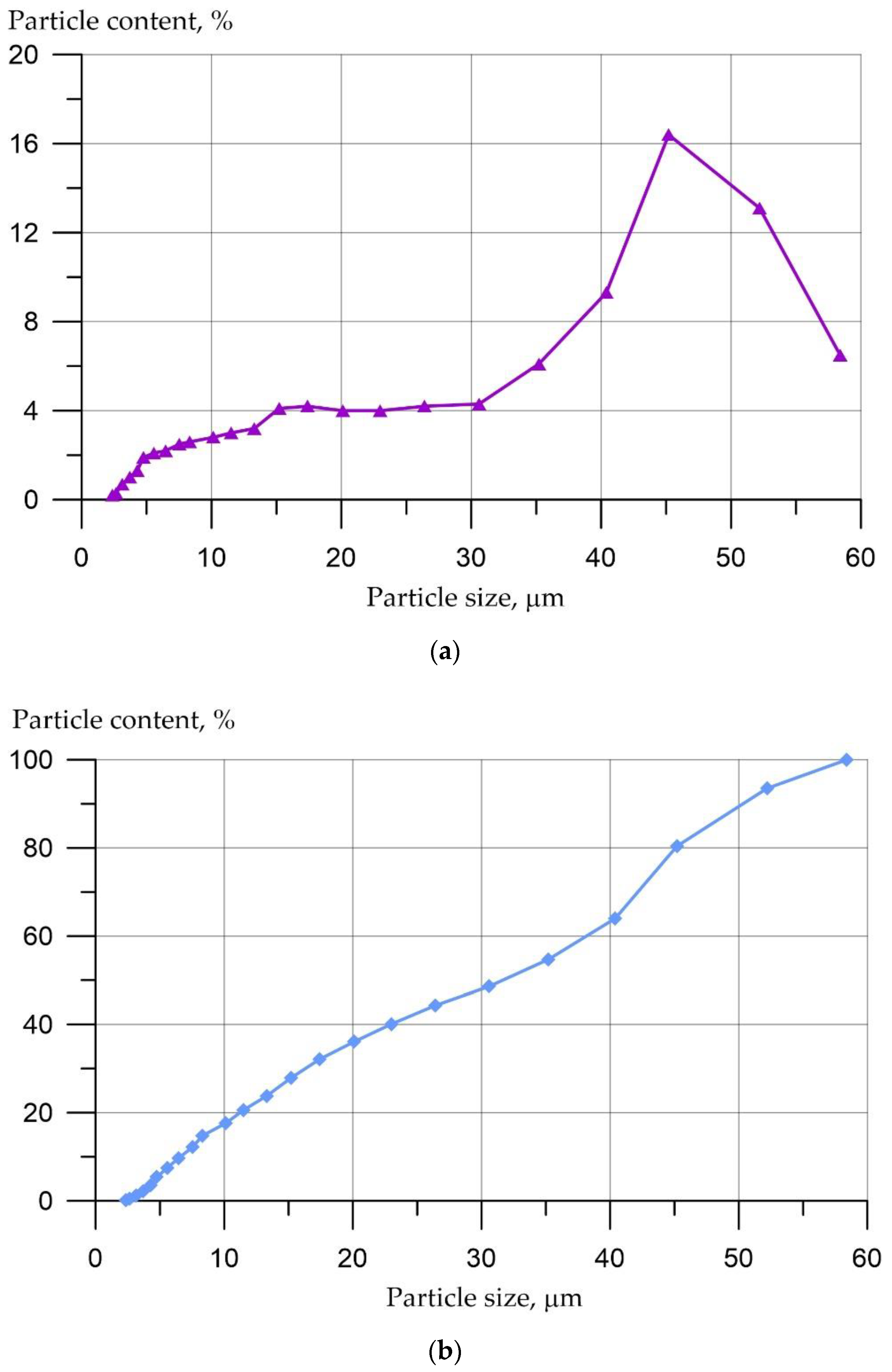
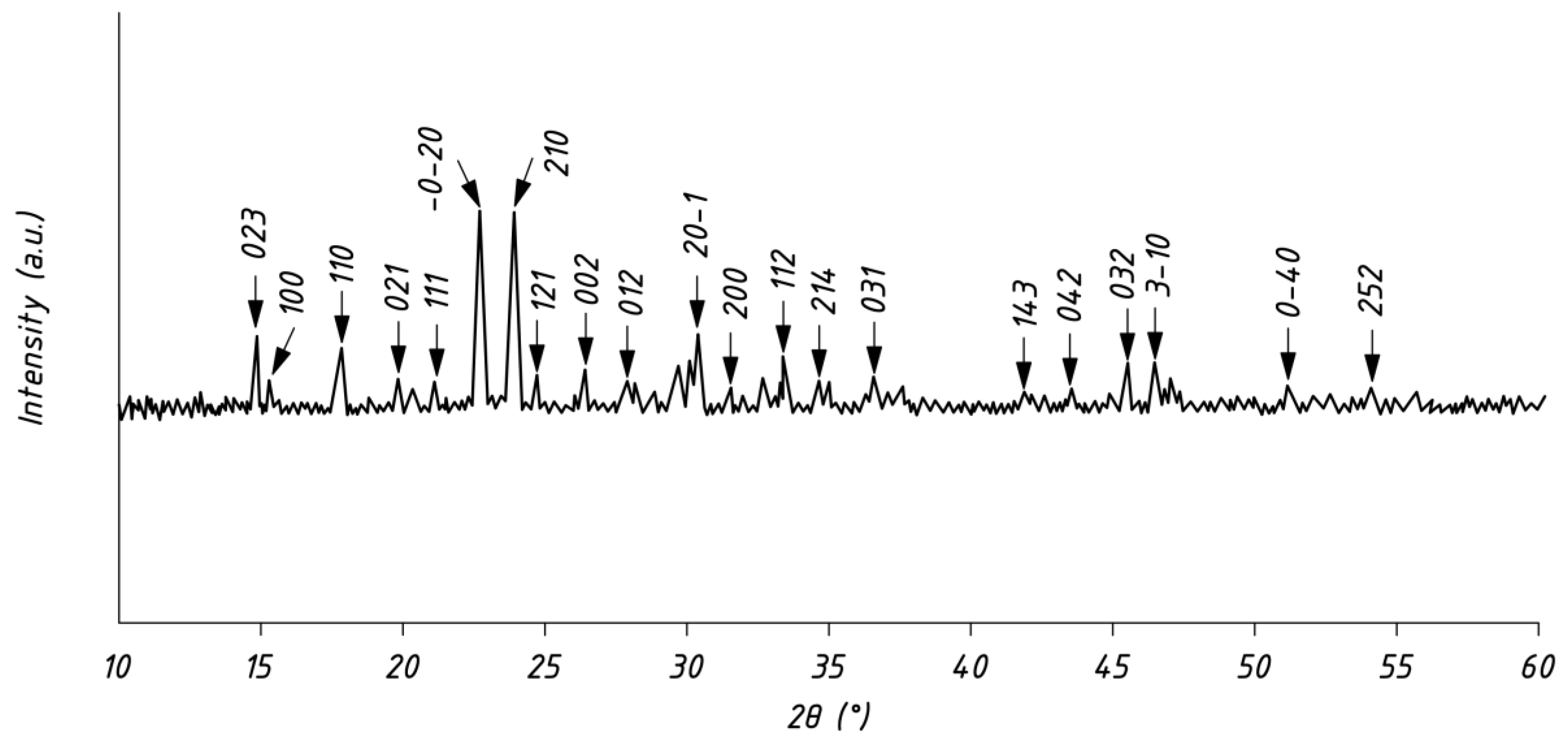
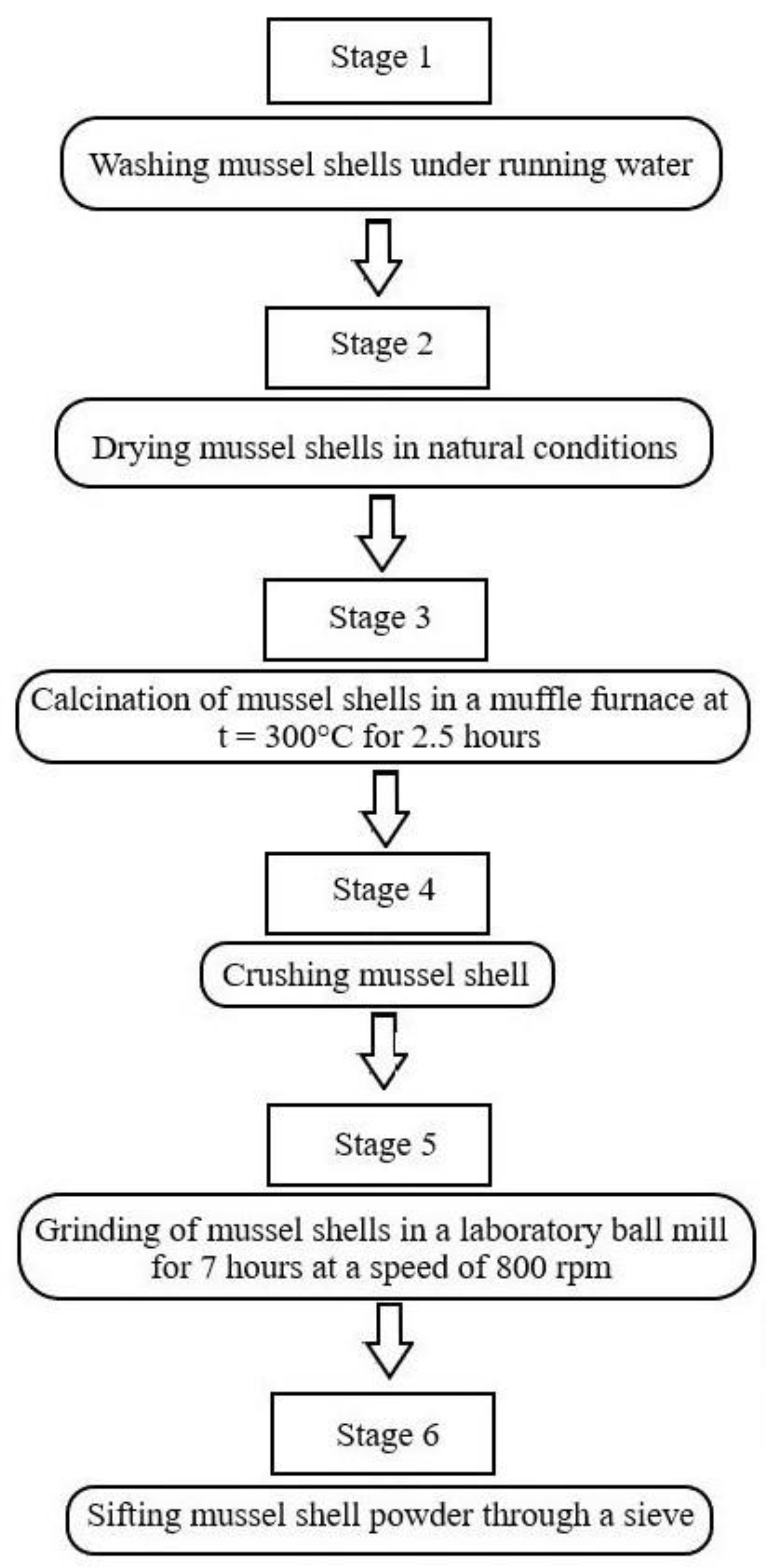
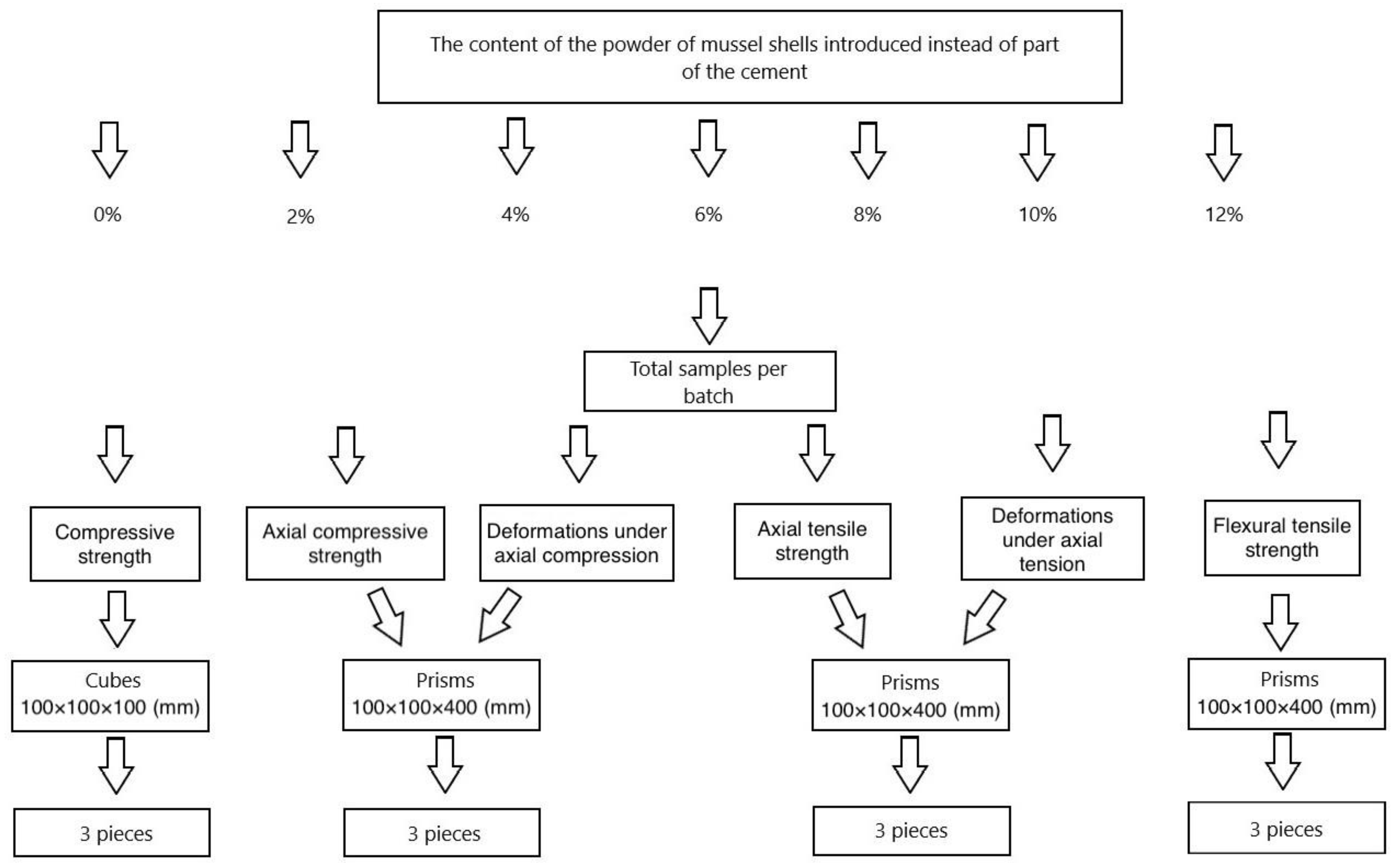
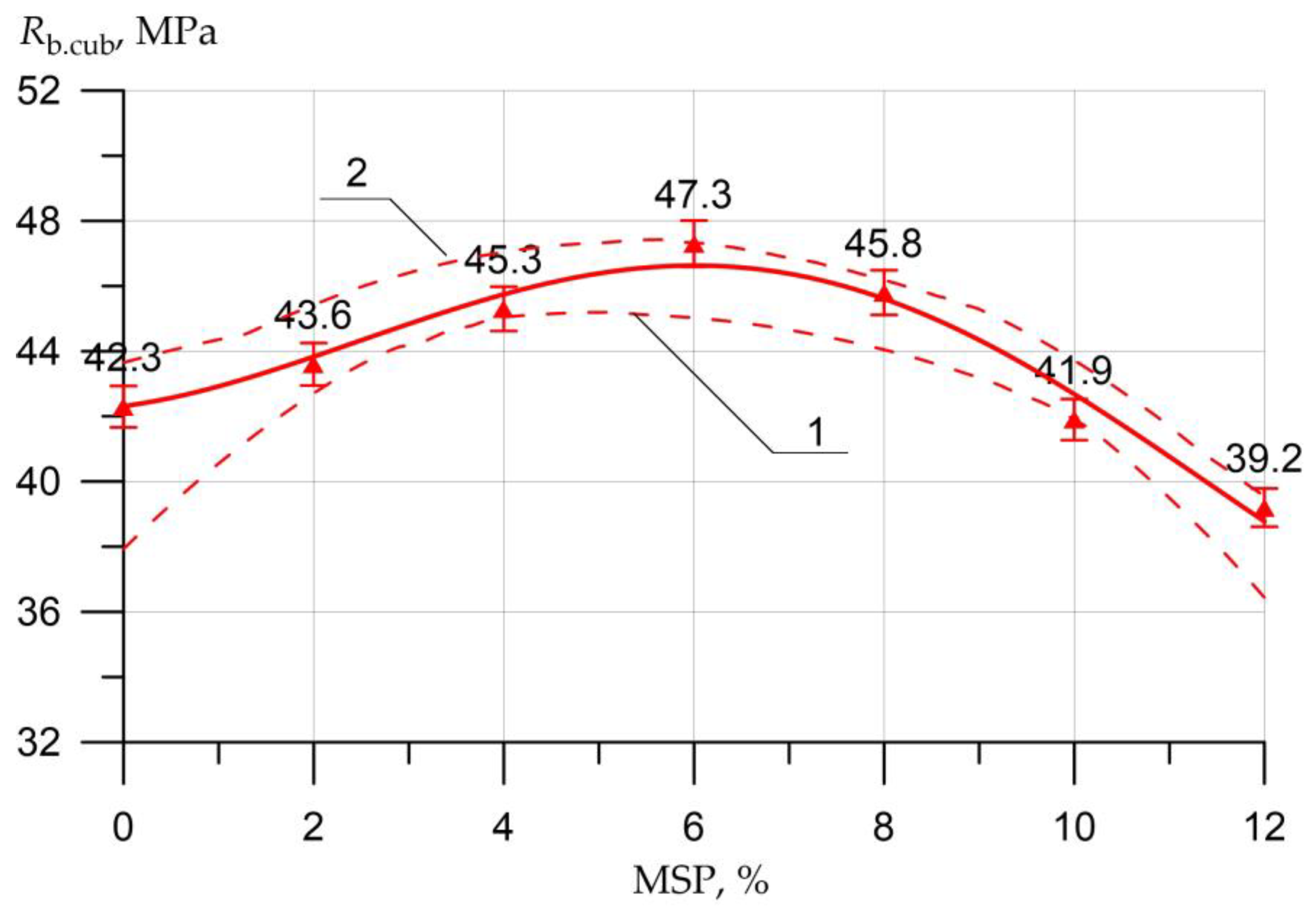
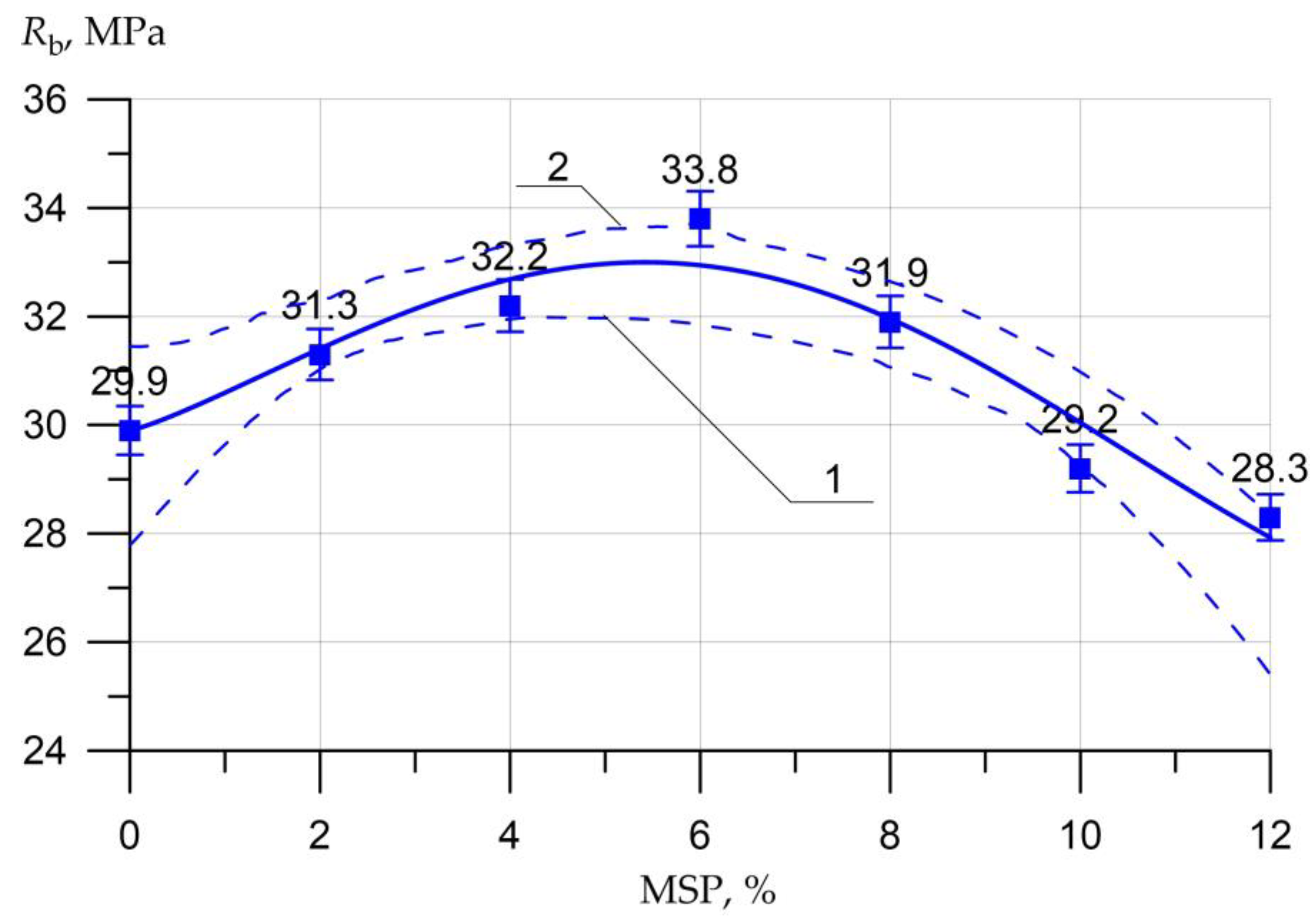


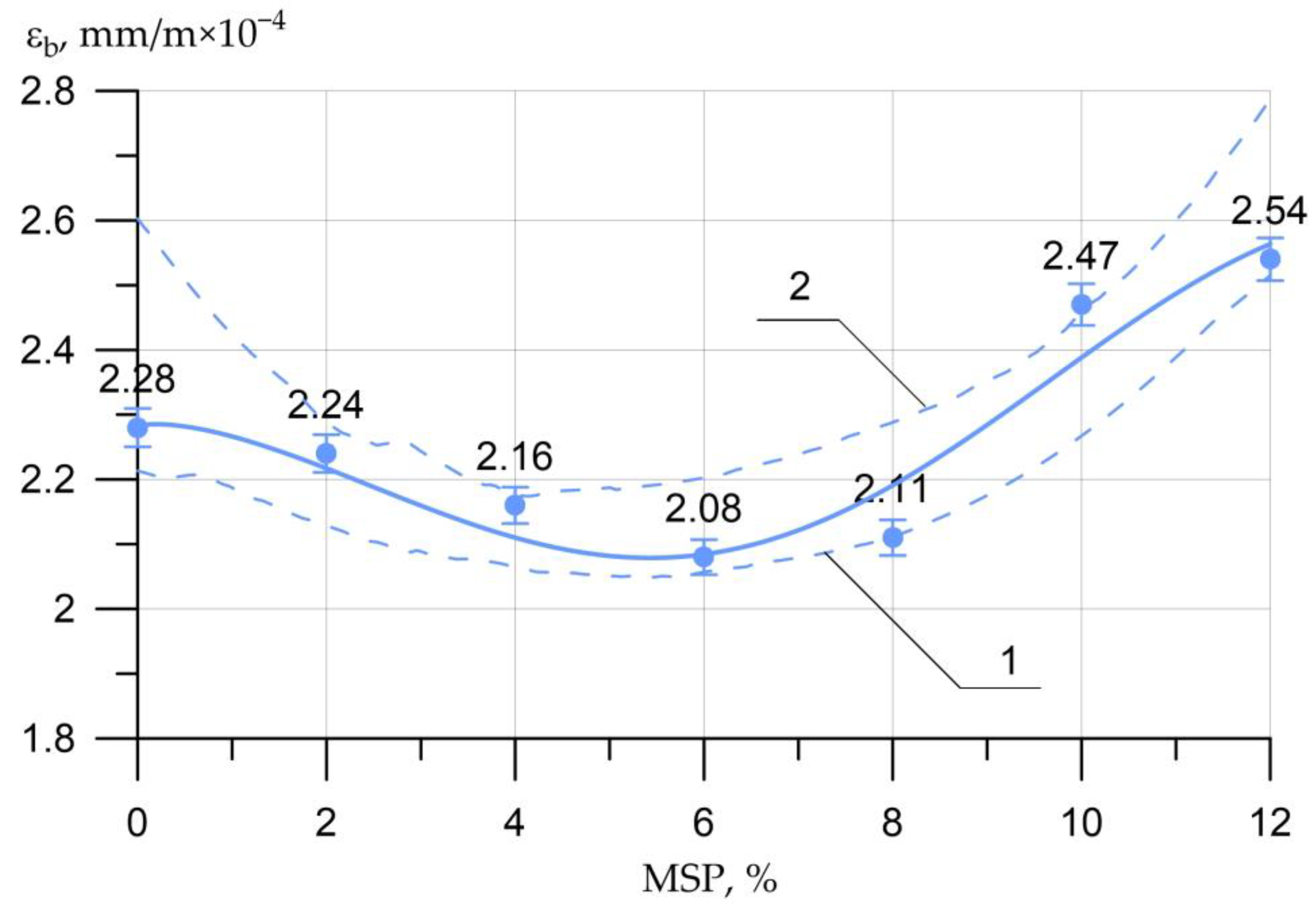
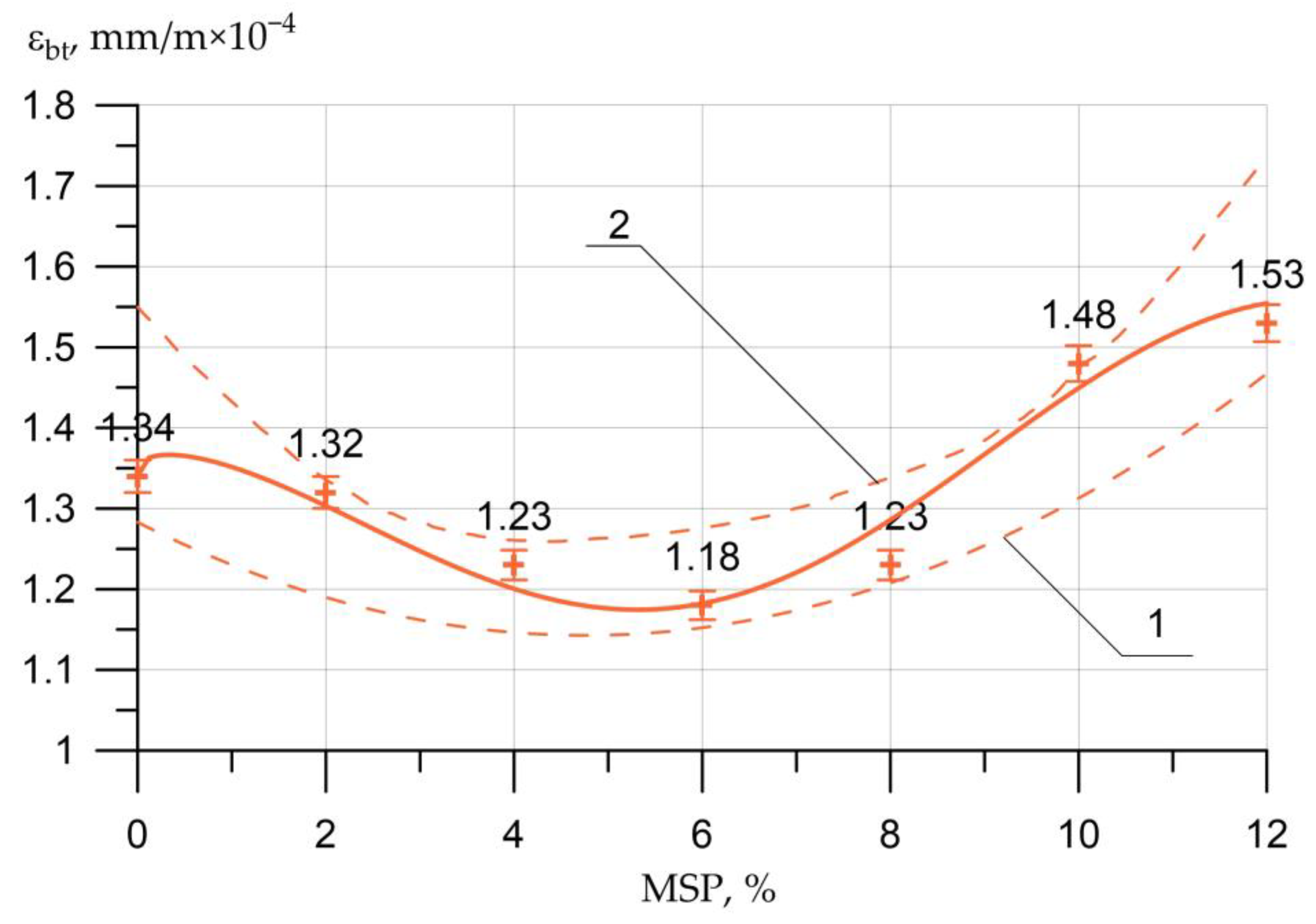
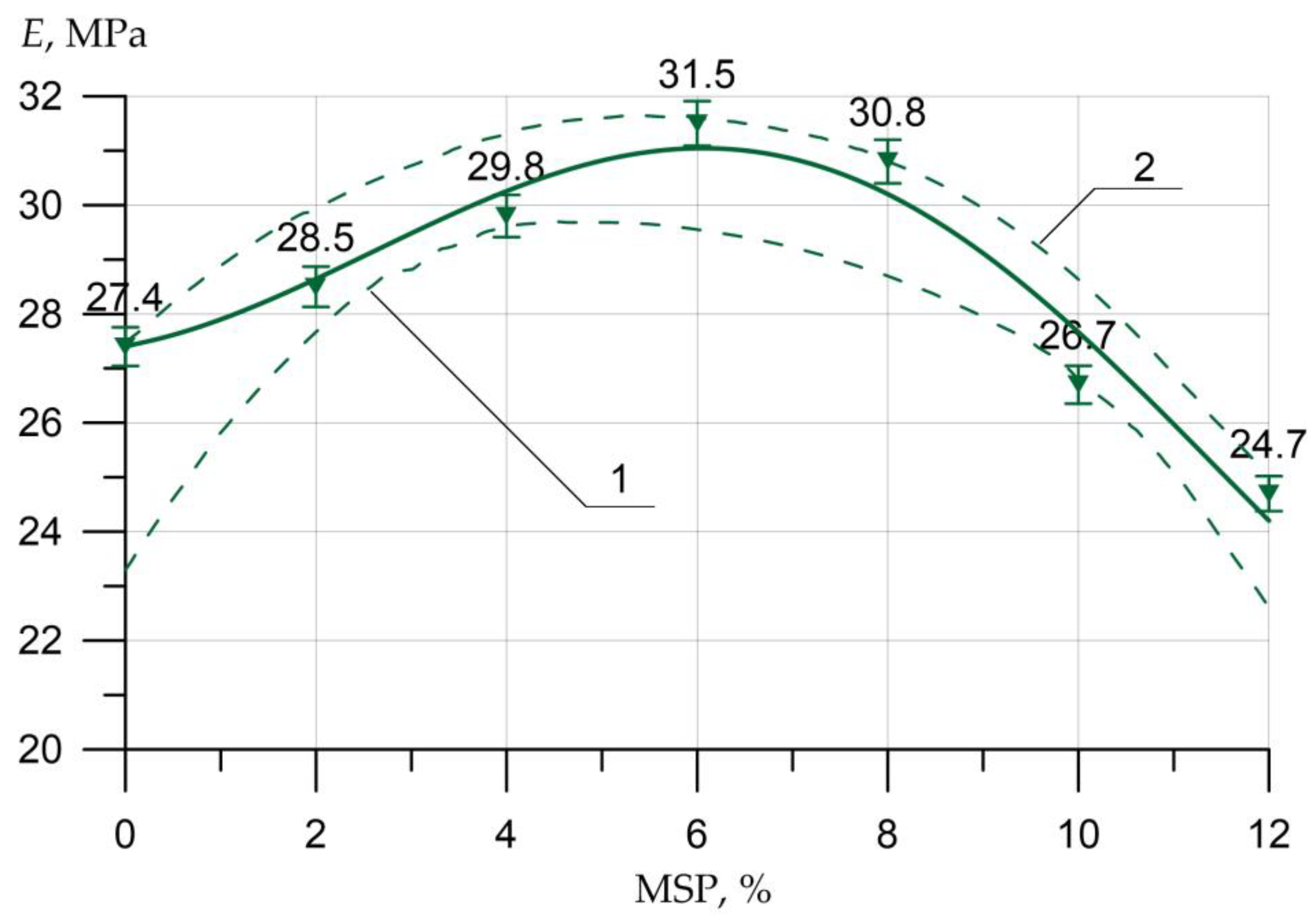

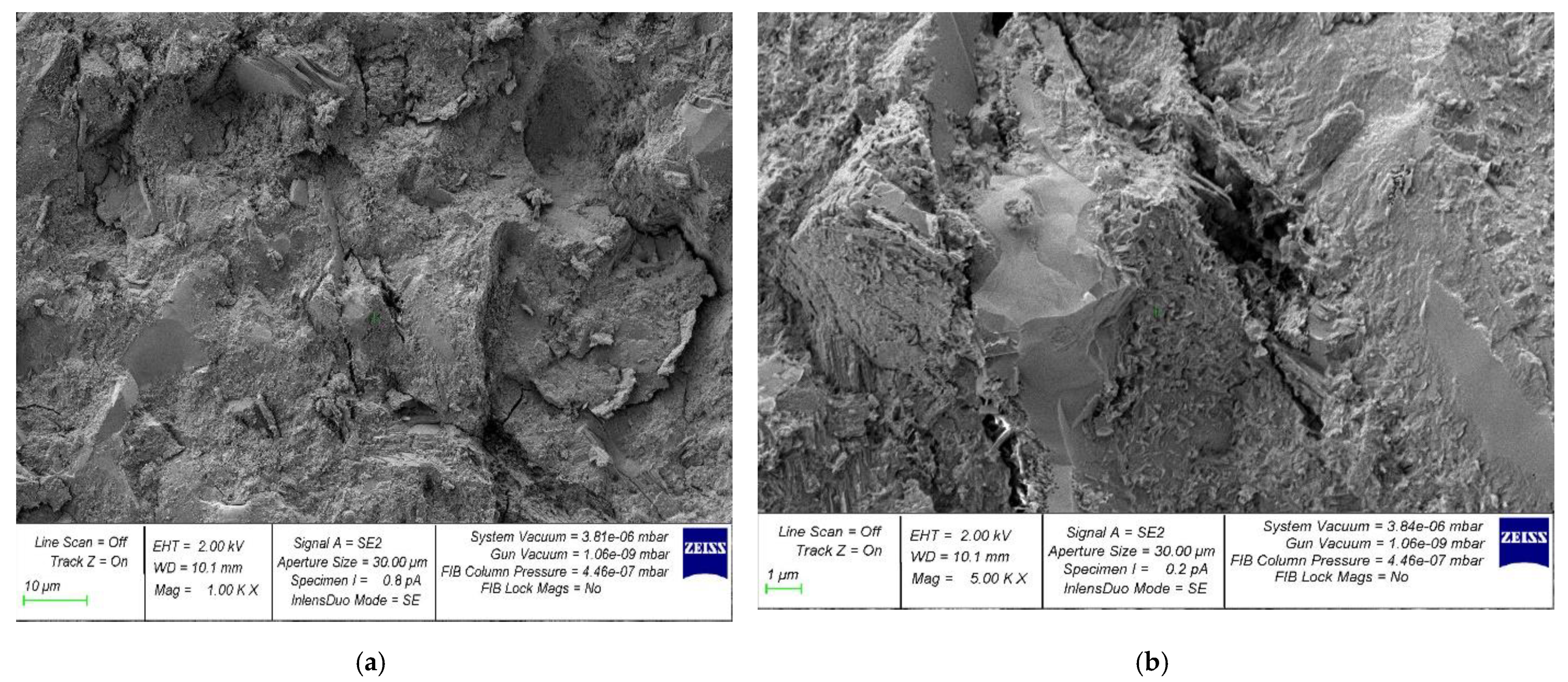


| Purpose of Waste | Reference | Effect of the Waste Type and Dosage on the Properties of the Developed Composite Materials |
|---|---|---|
| Modifier for asphalt | [16,17,18] | The use of seashell powder in [16] in asphalt pavement technology has a fairly good effect on the properties of this material. The resistance to high-temperature deformations is improved, the creep modulus increases, and the creep rate decreases. In [17], the authors studied the possibility of using fish scales as a modifying additive in asphalt in an amount from 4% to 16% by the weight of asphalt. It has been established that the use of this type of waste increases the “adhesion, viscoelastic properties, temperature susceptibility, and resistance to permanent deformation of asphalt” [17]. In [18], the use of fish scale powder in asphalt in similar dosages was also studied, and an improvement in the characteristics of the developed composite was also observed. |
| Additive in cement production | [19,20] | The “binary and ternary systems of cement with the addition of seashell powder” developed in the study [19] are more environmentally friendly, have the same compressive strength (CS), and can be successfully used as an analog of conventional Portland cement. A similar study was carried out in [20], according to the results of which it was found that the developed compositions of cement with shell powder are close to the same characteristics (“density, fineness, specific surface area, chemical composition, setting time, CS, and tensile strength (TS) in bending”) of conventional Portland cement without additives, which makes these types of cement competitive [20]. |
| Replacement of gypsum in the production of refractory materials | [21] | It was found that replacing gypsum with scallop shell powder at 40% and 50% by weight increased the resistance of the developed refractory materials to the acid attack in the first three weeks. However, then it started to decline. As for the CS, it deteriorated significantly by up to 80% compared to gypsum. |
| Expansion admixture in cement mortar | [22] | In the process of cement hydration, the introduction of “calcined oyster shell powder increases the heat of hydration at the initial stage of the reaction due to the dissolution of CaO and the formation of Ca(OH)2” [22]. According to “the results of the study, it was found that the content of this additive in the amount of 3% is optimal” [22]. |
| Binder replacement in heavy concrete technology | [23,24,25,26,27,28,29,30,31] | “Based on the results of experimental studies in [23], the authors found that the introduction of additional binders, such as oyster shell powder, foundry slag, and ground blast-furnace granulated slag”, makes it possible to obtain concretes with strength characteristics that are comparable to the values of control samples on ordinary Portland cement. In [24], the mechanical properties of concrete were studied when replacing cement with 5%, 10%, and 15% shell powder and replacing coarse aggregate with 10%, 20%, and 30% crushed seashells. In general, following the results of this investigation, the optimal limits for replacing shell waste in concrete were established: for cement–5% and for coarse aggregate–10%. In [25], the mechanical behavior of high-strength concrete with the addition of shell powder at elevated temperatures was studied. So, according to the results of the study, the samples modified with shells “showed a higher CS and modulus of elasticity than the control sample. According to the results of the study, it was found that the use of shell ash powder in an amount of 5% makes it possible to obtain concretes with improved durability and strength” [26]. Replacing part of the cement with industrial waste (microsilica/nanosilica [27], fly ash [28], blast furnace granulated slag and electric arc furnace dust [29], and recycled concrete powder [30]) with certain formulation methods, leads to an improvement in mechanical, thermal, and wear-resistant properties and makes it possible to obtain high-strength environmentally efficient concrete [31] |
| Binder component in geopolymer solution | [32,33] | The shell waste powder was used in [32] as a precursor for the preparation of an alkali-activated mortar, making it possible to obtain a mortar “with a CS of 22 MPa and a porosity of 16.5%” [32]. In [33], the authors investigated the effect of replacing a part of metakaolin with powder from scallop shells. “Replacing part of the metakaolin with shell powder” [33] makes it possible to obtain geopolymer mortars with higher mechanical strength, lower porosity, and shrinkage than similar metacolin-based mortars. |
| Aggregate | [15,34] | In [34], to create permeable concrete, natural aggregate was replaced with crushed seashells in an amount of 60% of the weight of the natural aggregate. Following the results of these experiments, the developed permeable concrete had lower frost resistance and “strength compared to the control composition” [34]. “The use of seashells as a fine aggregate” was studied in [15]. The authors found the use of sand from crushed seashells in self-compacting concrete by up to 100% to be acceptable and without violating the basic properties. Small drops in the values of CS and elasticity modulus were recorded only at a replacement of 100%. |
| Portland Cement (PC) without Additives CEM I 52.5 N (Novoroscement, Novorossiysk, Russia) | Granite Crushed Stone (CrS) (South-Nerud, Pavlovsk, Russia) | Quartz Sand (QS) (“Arkhipovsky quarry”, Village Arkhipovskoe, Russia) |
|---|---|---|
| The normal density of cement paste is 25%. Passage through a sieve with a mesh size of 0.08 mm−96%. TS in bending-7.7 MPa, CS-56.2 MPa | Particle size 5–10 mm. Bulk density (BD)-1486 kg/m3. True density (TD)-2630 kg/m3. Crushability-12.1 wt.%. The content of needle-shaped grains is 6.2 wt.% | Fineness modulus-1.86. BD-1438 kg/m3. TD-2667 kg/m3. The content of dust and clay particles is 0.9%. Clay content in lumps-0.2% |
| Element | O | C | Ca | Na | S | Mg | Si | Al |
|---|---|---|---|---|---|---|---|---|
| wt.% | 35.1 | 11.7 | 51.8 | 0.3 | 0.2 | 0.2 | 0.4 | 0.3 |
| Initial Materials | Actual Value |
|---|---|
| W/B | 0.5 |
| PC, kg/m3 | 380 |
| W, L/m3 | 192 |
| CrS, kg/m3 | 1261 |
| QS, kg/m3 | 714 |
| Concrete Characteristic | MSP, % | ||||||
|---|---|---|---|---|---|---|---|
| 0 | 2 | 4 | 6 | 8 | 10 | 12 | |
| Average density (kg/m3) | 2370 | 2373 | 2378 | 2381 | 2372 | 2365 | 2355 |
| MSP, % | 0 | 2 | 4 | 6 | 8 | 10 | 12 |
|---|---|---|---|---|---|---|---|
| ∆εb, % | 0 | –2 | –5 | –9 | –7 | 8 | 11 |
| ∆εbt, % | 0 | –1 | –8 | –12 | –8 | 10 | 14 |
Disclaimer/Publisher’s Note: The statements, opinions and data contained in all publications are solely those of the individual author(s) and contributor(s) and not of MDPI and/or the editor(s). MDPI and/or the editor(s) disclaim responsibility for any injury to people or property resulting from any ideas, methods, instructions or products referred to in the content. |
© 2022 by the authors. Licensee MDPI, Basel, Switzerland. This article is an open access article distributed under the terms and conditions of the Creative Commons Attribution (CC BY) license (https://creativecommons.org/licenses/by/4.0/).
Share and Cite
Stel’makh, S.A.; Shcherban’, E.M.; Beskopylny, A.N.; Mailyan, L.R.; Meskhi, B.; Tashpulatov, S.S.; Chernil’nik, A.; Shcherban’, N.; Tyutina, A. Composition, Technological, and Microstructural Aspects of Concrete Modified with Finely Ground Mussel Shell Powder. Materials 2023, 16, 82. https://doi.org/10.3390/ma16010082
Stel’makh SA, Shcherban’ EM, Beskopylny AN, Mailyan LR, Meskhi B, Tashpulatov SS, Chernil’nik A, Shcherban’ N, Tyutina A. Composition, Technological, and Microstructural Aspects of Concrete Modified with Finely Ground Mussel Shell Powder. Materials. 2023; 16(1):82. https://doi.org/10.3390/ma16010082
Chicago/Turabian StyleStel’makh, Sergey A., Evgenii M. Shcherban’, Alexey N. Beskopylny, Levon R. Mailyan, Besarion Meskhi, Salikh Sh. Tashpulatov, Andrei Chernil’nik, Natalya Shcherban’, and Anastasia Tyutina. 2023. "Composition, Technological, and Microstructural Aspects of Concrete Modified with Finely Ground Mussel Shell Powder" Materials 16, no. 1: 82. https://doi.org/10.3390/ma16010082
APA StyleStel’makh, S. A., Shcherban’, E. M., Beskopylny, A. N., Mailyan, L. R., Meskhi, B., Tashpulatov, S. S., Chernil’nik, A., Shcherban’, N., & Tyutina, A. (2023). Composition, Technological, and Microstructural Aspects of Concrete Modified with Finely Ground Mussel Shell Powder. Materials, 16(1), 82. https://doi.org/10.3390/ma16010082










